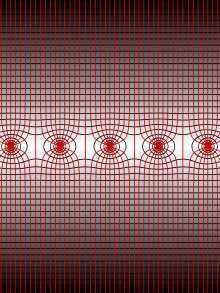- Wire chamber
-
A multi-wire chamber (or just wire chamber) is a detector for particles of ionizing radiation which is an advancement of the concept of the Geiger counter and the proportional counter.
A proportional counter uses a wire, under high voltage, which runs through a metal or conductive enclosure whose walls are held at ground potential. The enclosure is filled with carefully chosen gas, such as an argon/methane mix, such that any ionizing particle that passes through the tube will ionize surrounding gaseous atoms. The resulting ions and electrons are accelerated by the electric field around the wire, causing a localised cascade of ionization which is collected on the wire and results in an electric current proportional to the energy of the detected particle. This allows the experimenter to count particles and importantly, in the case of the proportional counter, to determine their energy.
For high energy physics experiments, it is also valuable to observe the particle's path. For a long time, bubble chambers were used for this purpose, but with the improvement of electronics, it became desirable to have a detector with fast electronic read-out. (In bubble chambers, photographs were made, printed and then looked through.) A wire chamber is a chamber with many parallel wires, arranged as a grid and put on high voltage, with the metal casing being on ground potential. As in the Geiger counter, a particle leaves a trace of ions and electrons, which drift toward the case or the nearest wire, respectively. By marking off the wires which had a pulse of current, one can see the particle's path.
An improvement is the multi-wire proportional chamber (MWPC) which combines this with the idea of the proportional counter to determine the energy. The 1968 invention of this device won Georges Charpak (then at CERN) the 1992 Nobel Prize in Physics and was named an IEEE Milestone in 2005.[1]
Often, the chamber is put into a homogeneous magnetic field, so that charged particles are led into spiral paths due to the Lorentz force. By checking the direction of the curves, one can see whether and how the particles are charged. The necessary magnetic fields are often quite strong: physicists at CERN like to tell visitors the story of how Charpak once was working on an MWPC, being so careless as to sit on an iron chair. He and his colleagues spent months carefully attaching thousands of thin wires. One day, he moved his chair a bit too close to the magnetic field. The magnet pulled his chair out from under him into the chamber, tearing apart all the wires and ruining the detector.
If one also precisely measures the timing of the current pulses of the wire and takes into account that the ions need some time to drift to the nearest wire, one can infer the distance at which the particle passed the wire. This greatly increases the accuracy of the path reconstruction and is known as a drift chamber.
If two drift chambers are used with the wires of one orthogonal to the wires of the other, both orthogonal to the beam direction, a more precise detection of the position is obtained. If an additional simple detector (like the one used in a veto counter) is used to detect, with poor or null positional resolution, the particle at a fixed distance before or after the wires, a tridimensional reconstruction can be made and the speed of the particle deducted from the difference in time of the passage of the particle in the different part of the detector. This setup gives up the detector called Time Projection Chamber (often written just TPC)
For measuring the velocity of the electrons in a gas (drift velocity) there are special drift chambers, Velocity Drift Chambers which measure the drift time for known location of ionisation.
See also
- Spark chamber
External links
References
- ^ "Milestones:CERN Experimental Instrumentation, 1968". IEEE Global History Network. IEEE. http://www.ieeeghn.org/wiki/index.php/Milestones:CERN_Experimental_Instrumentation,_1968. Retrieved 4 August 2011.
Categories:- Particle detectors
- Laboratory equipment
Wikimedia Foundation. 2010.





